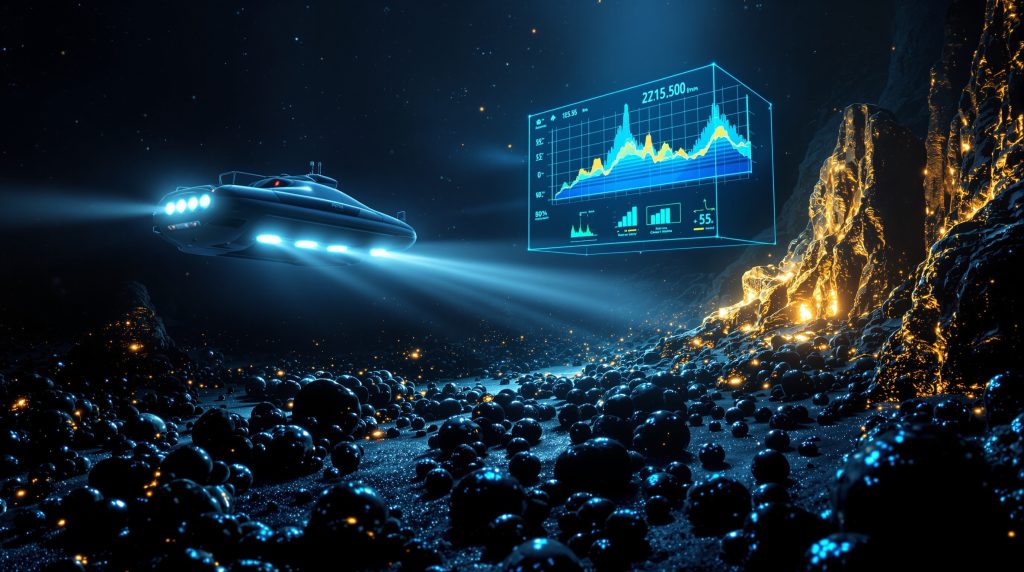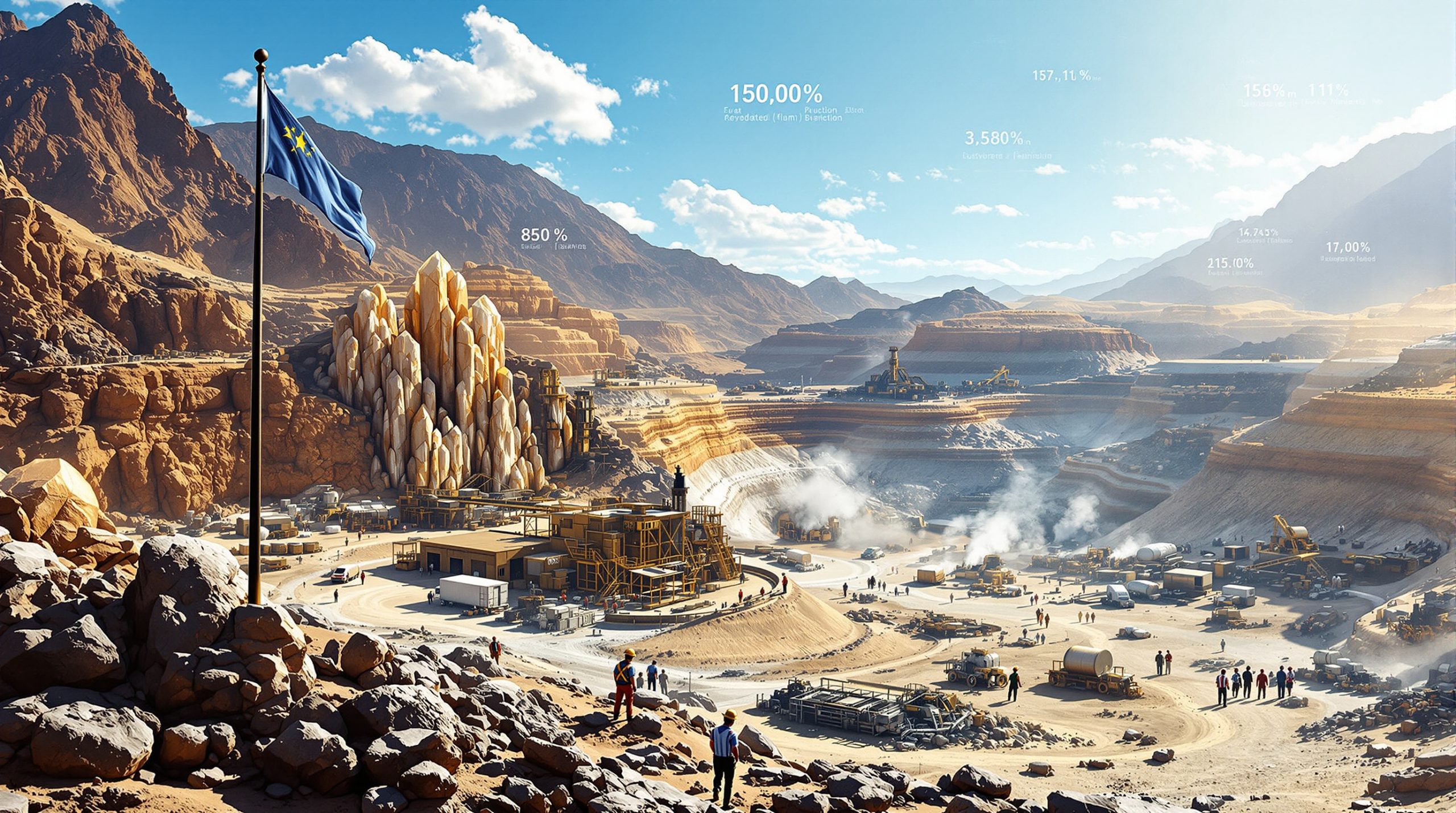What Is Deep-Sea Mineral Exploration and Why Does It Matter?
Deep-sea mineral exploration represents humanity's pursuit of critical resources from Earth's most challenging frontier. As global demand for essential metals like copper, nickel, and cobalt continues to surge, mining companies are directing their attention toward the vast mineral wealth lying thousands of metres beneath the ocean's surface, exploring the polymetallic nodules benefits for future resource security.
The ocean floor contains three primary types of mineral deposits that attract exploration efforts: polymetallic nodules scattered across abyssal plains, cobalt-rich crusts coating underwater mountains, and polymetallic sulfides surrounding hydrothermal vents. These formations contain concentrations of metals often exceeding those found in terrestrial mines.
According to the International Seabed Authority, polymetallic nodules contain manganese (24-30%), nickel (1.3%), copper (1.1%), and cobalt (0.2%), with concentrations that can significantly exceed land-based ore grades. The Clarion-Clipperton Zone in the Pacific Ocean alone contains an estimated 21 billion dry tons of polymetallic nodules, potentially holding 6 billion tons of manganese, 272 million tons of nickel, 44 million tons of cobalt, and 82 million tons of copper.
Understanding Current Supply Constraints
Current projections indicate that land-based mining operations will struggle to satisfy the growing appetite for critical minerals needed in renewable energy technologies, electric vehicles, and digital infrastructure. The International Energy Agency projects that demand for critical minerals like lithium could increase by over 40 times by 2040 under sustainable development scenarios, while copper and rare earth elements demand could double.
The increasing growth of populations and economies worldwide will lead to a growing need for raw materials, as recognised by industry analysts. However, the mining industry evolution shows that circular economy and recycling alone will not be sufficient to meet this increasing demand. This supply-demand imbalance has prompted governments and corporations to invest billions in developing deep-sea mineral exploration capabilities.
Research from the Royal Society suggests that accessing new mineral provinces, including deep-sea environments, may become necessary to meet projected demand for battery metals and clean energy infrastructure. Terrestrial mining expansion faces increasing constraints including declining ore grades, water scarcity, and social licence challenges.
Strategic Mineral Importance
The global transformation towards a digital, electrified and decarbonised society requires expanding access to strategically important minerals and metals. Furthermore, raw materials such as copper are essential for energy transformation and digitalisation, positioning deep-sea mineral exploration within broader sustainability transitions.
How Does Deep-Sea Mineral Exploration Technology Work?
Modern deep-sea mineral exploration relies on sophisticated autonomous underwater vehicles (AUVs) and remotely operated vehicles (ROVs) equipped with high-resolution cameras, sonar mapping systems, and precision sampling equipment. These robotic platforms can operate at depths exceeding 6,000 metres while maintaining constant communication with surface vessels.
Advanced Underwater Survey Systems
Exploration teams employ multiple complementary techniques to evaluate seabed mineral deposits, building upon the mineral exploration importance principles used in terrestrial operations:
- Electromagnetic surveys detect metallic concentrations beneath the seafloor
- Seismic profiling reveals geological structures and deposit thickness
- Gravity measurements identify density variations indicating mineral presence
- Magnetic surveys locate sulfide deposits near hydrothermal activity
Modern autonomous underwater vehicles can operate continuously for up to 72 hours at depths exceeding 6,000 metres with positioning accuracy within 10 metres using acoustic systems. Multibeam sonar systems can map seafloor areas up to 6 times the water depth in a single pass, providing bathymetric resolution of 1-5 metres at 5,000 metres depth.
Innovative Sampling Technologies
The second phase of the Deep Sea Sampling (DSS II) project, launched in September 2025, represents a significant advancement in exploration technology. This project aims to develop a lightweight, compact deep-sea platform that can withstand pressures at depths of 4,000 metres and extract rock samples selectively at multiple locations.
| Technology Component | Specification | Operational Depth |
|---|---|---|
| Pressure Resistance | 400 bar (40 MPa) | 4,000 metres |
| Platform Design | Lightweight, compact | Multiple locations |
| Processing Method | Closed-circuit system | On-site separation |
| Timeline | Phase II: 2025-2028 | Full deployment ready |
The DSS II project focuses on adapting proven diaphragm wall construction methods for deep-sea applications. This approach ensures a closed-circuit process that prevents contamination from entering the environment by separating seawater and rock particles directly on the seafloor and reintroducing treated flushing fluid back into the system.
Geological Assessment Methods
Specialised drilling systems extract core samples from target areas, allowing geologists to determine mineral composition, concentration levels, and extraction feasibility. Advanced laboratory analysis provides detailed metallurgical data essential for economic assessment.
For research purposes, more information and data about geology and sea environment is needed to support comprehensive deep-sea mineral exploration programmes. The selective sampling capabilities being developed will enable extraction of rock samples at multiple precise locations rather than continuous collection methods that may disturb larger seafloor areas.
What Are the Major Challenges in Deep-Sea Exploration?
Deep-sea mineral exploration presents unprecedented technical challenges that push engineering capabilities to their limits. In addition, the extreme environment thousands of metres below the ocean surface creates conditions unlike anywhere else on Earth.
Extreme Environmental Conditions
The pressure on the sea floor reaches up to 400 bar, equivalent to the weight of a small car concentrated over an area the size of a postage stamp. Consequently, equipment operating in these conditions needs to be both robust and highly precise.
| Challenge | Impact | Depth Range |
|---|---|---|
| Pressure | 400+ bar (40 MPa or ~5,800 psi) | 4,000+ metres |
| Temperature | Near-freezing conditions (2-4°C) | Most depths |
| Corrosion | Marine environments cause 10-100x higher corrosion rates | All depths |
| Darkness | Complete absence of natural light | 200+ metres |
Deep ocean temperatures remain stable at 2-4°C year-round below 1,000 metres depth, creating additional challenges for equipment operation and maintenance. Marine environments can cause corrosion rates 10-100 times higher than atmospheric conditions depending on materials used.
Technical Equipment Requirements
Complete darkness, steep slopes, and the complex topography of deep-sea deposits pose further challenges beyond pressure and temperature. Deep-sea mineral exploration equipment must withstand crushing pressures while maintaining precise operational control.
This necessitates specialised materials including:
- Titanium alloys and specialised stainless steels for pressure vessels due to their strength-to-weight ratios and corrosion resistance
- Syntactic foam materials (typically epoxy resin with hollow glass microspheres) providing buoyancy while withstanding pressure at depths exceeding 6,000 metres
- Redundant systems and innovative engineering solutions that significantly increase development costs
Navigation and Communication Challenges
Unlike terrestrial mining, deep-sea mineral exploration operations cannot rely on GPS signals. Electromagnetic waves (including radio and GPS) are severely attenuated in seawater, with penetration limited to a few metres for most frequencies.
Acoustic systems provide the primary communication method but face bandwidth limitations of typically 10-50 kbps at operational ranges. Long baseline (LBL) and ultra-short baseline (USBL) systems provide positioning accuracy of 1-5 metres at depths up to 11,000 metres without GPS signals.
"Navigation accuracy becomes paramount when equipment must operate with precision in complete darkness while managing extreme pressure differentials and complex seafloor topography."
Which Technologies Are Revolutionising Deep-Sea Exploration?
Several breakthrough technologies are transforming deep-sea mineral exploration capabilities, making operations more efficient while reducing environmental impact. These advances complement broader deep‐sea mining controversies discussions by offering more sustainable approaches.
Compact Electrified Cutting Systems
The DSS II project represents a significant technological leap forward in deep-sea mineral exploration. During Phase I (2021-2024), project partners explored the technical feasibility of a compact, electrified deep-sea cutter based on diaphragm wall technology.
The closed-circuit processing system eliminates the need for energy-intensive pumping to surface vessels, significantly reducing operational power requirements. Traditional riser systems can require 2-5 MW of pumping power for lifting material from 4,000+ metre depths.
Vertical Approach Innovation
The concept is based on Bauer's diaphragm wall method, ensuring a closed-circuit process to prevent contamination from entering the environment as far as possible. Seawater and rock particles are separated on site right on the sea floor, and the treated flushing fluid is reintroduced back into the process.
This approach offers several advantages:
- Eliminates energy-intensive pump systems reaching the ocean surface
- Reduces sediment plume generation through on-site processing
- Enables selective sampling at multiple locations
- Minimises ecological footprint through closed-circuit operations
Real-Time Data Processing
Advanced computing systems now enable real-time analysis of geological data during deep-sea mineral exploration, allowing exploration teams to adjust survey patterns and sampling strategies without returning to port. For instance, this capability dramatically reduces exploration timeframes and costs.
The DSS II consortium includes an interdisciplinary team of geoscientists, maritime experts, and engineers working strategically to develop forward-looking solutions. This collaborative approach accelerates innovation while addressing both technical and environmental challenges.
Modular Platform Design
Phase II focuses on developing a lightweight, compact deep-sea platform capable of withstanding pressures at depths of 4,000 metres. The platform must operate in complete darkness with autonomous or remotely controlled functionality while maintaining precision operations.
Next-generation exploration platforms feature modular construction, enabling rapid reconfiguration for different deposit types and environmental conditions. This flexibility allows single platforms to explore multiple target areas during extended deployments.
What Environmental Considerations Shape Exploration Practices?
Environmental protection and minimising ecological footprint represent core objectives of modern deep-sea mineral exploration practices. However, the unique and fragile nature of deep-sea ecosystems demands specialised approaches to resource assessment, similar to mine reclamation innovation principles applied on land.
Ecosystem Impact Assessment
Deep-sea environments host unique biological communities that have evolved over millions of years in stable conditions. The Clarion-Clipperton Zone harbours an estimated 5,578-8,960 species in areas designated for polymetallic nodule mining, with 75% of macrofaunal species potentially new to science.
Deep-sea mineral exploration activities must carefully evaluate potential impacts on these fragile ecosystems through comprehensive environmental baseline studies. Recovery timelines for disturbed areas may extend to decades or centuries, making impact prevention crucial.
Sediment Disturbance Minimisation
Research from the World Resources Institute indicates that sediment plumes generated by seafloor disturbance can travel hundreds of kilometres from mining sites, potentially impacting deep-sea ecosystems through increased turbidity, particle deposition, and habitat disruption.
The DSS II project addresses this challenge through holistic consideration of marine resources with regard to ecological and economic factors. The closed-circuit approach aims to prevent contamination from entering the environment as far as possible through on-site separation and fluid reintroduction.
Modern deep-sea mineral exploration techniques prioritise minimal seafloor disturbance through:
- Precision sampling targeting specific locations rather than broad area collection
- Closed-loop processing systems preventing sediment plume generation
- On-site separation eliminating need for surface transport of mixed materials
- Treated fluid reintroduction maintaining local water chemistry balance
Biodiversity Protection Protocols
"Requirements for ecological and social standards are becoming stricter when it comes to the extraction of raw materials, necessitating proactive and objective evaluation of technological options."
The DSS II project aims to identify ways of extracting metals with minimal impact on the natural environment. This approach recognises that environmental considerations must be integrated into technology development from the earliest stages rather than addressed as an afterthought.
Deep-sea mineral exploration companies now conduct extensive biological surveys before beginning mineral assessment, creating detailed inventories of local species and habitats to inform environmental management strategies.
How Do Companies Evaluate Deep-Sea Mineral Deposits?
Economic evaluation of deep-sea mineral exploration prospects requires comprehensive analysis that accounts for unique operational challenges and environmental considerations.
Resource Assessment Requirements
For research purposes, more information and data about geology and sea environment is needed to support comprehensive deposit evaluation. The DSS II project addresses this challenge by developing platforms capable of selective sampling at multiple locations for geological assessment.
Deep-sea mineral exploration evaluation involves:
- Development of platforms capable of selective sampling at multiple locations
- Extraction of rock samples for geological assessment and metallurgical testing
- Environmental data collection for baseline studies and impact assessment
- Preliminary investigation for minimally invasive mining concepts
Economic Feasibility Analysis
Successful deep-sea mineral exploration requires comprehensive economic modelling that accounts for unique operational challenges and costs. Analysis must consider factors including:
- Resource grade and tonnage estimates based on selective sampling data
- Extraction technology requirements including specialised deep-sea equipment
- Transportation and processing costs from remote ocean locations
- Regulatory compliance expenses for environmental protection measures
- Environmental mitigation investments throughout project lifecycle
Market Demand Integration
The evaluation process recognises that the increasing growth of populations and economies worldwide will lead to growing need for raw materials. The circular economy and recycling alone will not be enough to meet this increasing demand.
Deep-sea mineral exploration decisions increasingly depend on long-term market forecasts for critical minerals, particularly those essential for clean energy technologies and digital infrastructure development. Raw materials such as copper are essential for energy transformation and digitalisation, creating sustained demand drivers.
Risk Assessment Framework
Companies employ sophisticated risk management models to evaluate technical, environmental, and financial uncertainties associated with deep-sea mineral exploration projects. These frameworks help prioritise exploration targets and optimise resource allocation across multiple prospects.
The challenging operational environment requires robust risk assessment covering:
- Technical risks related to extreme pressure and environmental conditions
- Environmental risks affecting marine ecosystems and regulatory approval
- Financial risks associated with high development costs and uncertain returns
- Regulatory risks from evolving international governance frameworks
What Does the Future Hold for Deep-Sea Mineral Exploration?
The future of deep-sea mineral exploration will be shaped by technological advancement, regulatory evolution, and growing demand for critical minerals essential to global sustainability transitions.
Technology Development Timeline
The DSS II project establishes a concrete development timeline extending to 2028 for achieving key technological milestones including lightweight platform development and minimally invasive mining concept validation. This timeframe provides a clear pathway for transitioning from exploration to potential extraction operations.
The next decade promises significant improvements in deep-sea mineral exploration efficiency through:
- Artificial intelligence integration for real-time geological assessment and decision-making
- Autonomous fleet coordination enabling simultaneous multi-site operations
- Advanced materials science applications reducing equipment weight while maintaining strength
- Battery technology advances enabling longer autonomous operations without surface support
International Regulatory Evolution
Global governance frameworks for deep-sea mineral exploration and mining continue evolving, with international bodies working to establish comprehensive environmental standards and benefit-sharing mechanisms. These regulations will significantly influence exploration strategies and investment decisions.
The International Seabed Authority currently manages 31 active exploration contracts across the Clarion-Clipperton Zone, Mid-Atlantic Ridge, and Indian Ocean, representing 168 contracting states as of 2024. This regulatory framework continues developing to balance resource development with environmental protection.
Industry Collaboration Trends
Successful deep-sea mineral exploration increasingly requires collaboration between mining companies, technology developers, research institutions, and environmental organisations. Furthermore, the DSS II consortium exemplifies this multidisciplinary approach, bringing together diverse expertise to accelerate innovation while addressing sustainability concerns.
This collaborative model offers several advantages:
- Shared risk and investment across multiple stakeholders
- Integrated expertise combining technical, environmental, and economic perspectives
- Accelerated innovation through cross-sector knowledge transfer
- Enhanced environmental stewardship through proactive impact assessment
Market Demand Drivers
The global transformation towards a digital, electrified and decarbonised society continues driving demand for strategically important minerals and metals. Deep-sea mineral exploration represents a potential alternative source of raw materials to supplement terrestrial mining operations.
Long-term demand projections support continued investment in deep-sea mineral exploration technologies, particularly as requirements for ecological and social standards become stricter for conventional mining operations.
Environmental Stewardship in Deep-Sea Operations
The evolution of deep-sea mineral exploration demonstrates industry commitment to environmental protection through technological innovation and collaborative research.
Minimally Invasive Approaches
The DSS II project specifically aims to identify ways of extracting metals with minimal impact on the natural environment. This objective reflects broader industry recognition that sustainable resource development requires proactive environmental consideration from the earliest exploration phases.
Preliminary investigation for minimally invasive mining concepts based on vertical cutter technology represents a significant departure from traditional approaches that may cause widespread seafloor disturbance.
Holistic Resource Consideration
Phase II focuses on holistic consideration of marine resources with regard to ecological and economic factors, recognising that successful deep-sea mineral exploration must balance resource development opportunities with environmental protection responsibilities.
This integrated approach ensures that technological development proceeds with full awareness of environmental implications, creating pathways for responsible resource access that supports global sustainability goals.
Conclusion: Balancing Innovation with Responsibility
Deep-sea mineral exploration stands at the intersection of technological innovation and environmental stewardship, offering potential solutions to critical resource challenges while demanding unprecedented levels of scientific precision and ecological responsibility.
The DSS II project and similar initiatives demonstrate that industry leadership recognises the need for proactive and objective evaluation of technological options. By 2028, these developments may establish proven pathways for accessing deep-sea minerals while maintaining environmental integrity.
As exploration technologies continue advancing and regulatory frameworks mature, deep-sea mineral exploration may become an essential component of global resource supply chains. The success of these endeavours will ultimately depend on industry ability to balance economic objectives with environmental protection, ensuring that deep-sea resources contribute to sustainable development rather than ecological degradation.
The interdisciplinary collaboration exemplified by projects like DSS II suggests that deep-sea mineral exploration can advance through responsible innovation, creating value for society while preserving marine ecosystems for future generations. This balanced approach may unlock humanity's next major source of essential minerals while establishing new standards for environmental stewardship in resource development.
Could Deep-Sea Discoveries Transform Your Investment Portfolio?
Discovery Alert's proprietary Discovery IQ model delivers real-time alerts on significant ASX mineral discoveries, including emerging opportunities in deep-sea exploration companies and critical mineral producers. As traditional mining faces increasing constraints and deep-sea mineral exploration advances toward commercial viability by 2028, Discovery Alert ensures you're positioned ahead of market movements that could reshape the mining sector. Begin your 30-day free trial today and discover why major mineral discoveries can generate substantial returns by exploring our dedicated discoveries page showcasing historic examples of exceptional outcomes.




